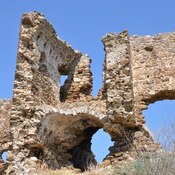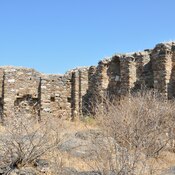Es gibt noch keine deutschsprachige Anmerkungen. Präsentiert wirden Anmerkungen auf English.
Theodor Wiegand the archaic temple on the lower terrace was Pausanias`Dionysus temple :" The people of Myus left their city on account of the following accident. A small inlet of the sea used to run into their land. This inlet the river Maeander turned into a lake, by blocking up the entrance with mud. When the water, ceasing to be sea, became fresh,2 gnats in vast swarms bred in the lake until the inhabitants were forced to leave the city. They departed for Miletus, taking with them the images of the gods and their other movables, and on my visit I found nothing in Myus except a white marble temple of Dionysus."1. He suggested that Apollo Termintheus and Poseidon were also worshipped in this temple. E. Akurgal argued that the t temple facing west althougth there is enough room on the east to erect altar suggests rather that was temple of Artemis associated with an ancient Anatolian mother-goddess2.
Sources:
- Ekrem Akurgal, Ancient Civilisations and Ruins of Turkey: From Prehistoric Times until the end of the Roman Empire, Turkish Historical Society Press, Ankara 1970, p. 244-246
- http://tayproject.org/TAYages.fm$Retrieve?CagNo=5349&html=ages_detail_e.html&layout=web
- Pausanias, Description of Greece. Achaia VII.2
Referenzen
- ↑ Pausanias, Description of Greece. Achaia VII. Chapter II.10-11
- ↑Ekrem Akurgal, Ancient Civilisations and Ruins of Turkey: From Prehistoric ... Turkish Historical Society Press, Ankara 1970, p.239
Theodor Wiegand the archaic temple on the lower terrace was Pausanias`Dionysus temple :" The people of Myus left their city on account of the following accident. A small inlet of the sea used to run into their land. This inlet the river Maeander turned into a lake, by blocking up the entrance with mud. When the water, ceasing to be sea, became fresh,2 gnats in vast swarms bred in the lake until the inhabitants were forced to leave the city. They departed for Miletus, taking with them the images of the gods and their other movables, and on my visit I found nothing in Myus except a white marble temple of Dionysus."1. He suggested that Apollo Termintheus and Poseidon were also worshipped in this temple. E. Akurgal argued that the t temple facing west althougth there is enough room on the east to erect altar suggests rather that was temple of Artemis associated with an ancient Anatolian mother-goddess2.
Sources:
- Ekrem Akurgal, Ancient Civilisations and Ruins of Turkey: From Prehistoric Times until the end of the Roman Empire, Turkish Historical Society Press, Ankara 1970, p. 244-246
- http://tayproject.org/TAYages.fm$Retrieve?CagNo=5349&html=ages_detail_e.html&layout=web
- Pausanias, Description of Greece. Achaia VII.2
Referenzen
- ↑ Pausanias, Description of Greece. Achaia VII. Chapter II.10-11
- ↑Ekrem Akurgal, Ancient Civilisations and Ruins of Turkey: From Prehistoric ... Turkish Historical Society Press, Ankara 1970, p.239


